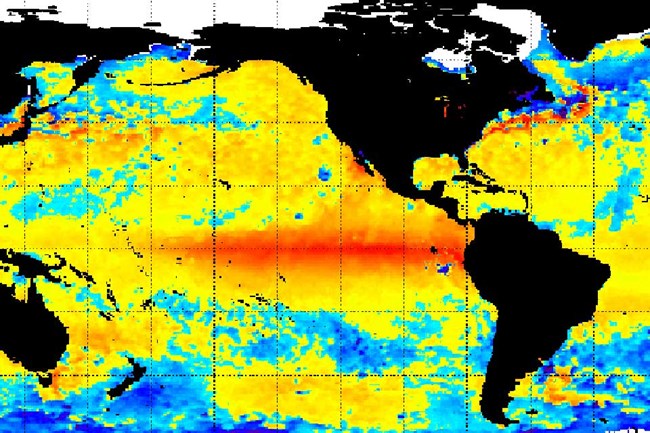
Ocean and climate conditions at Channel Islands National Park are partly the result of long-term cycles that play out across the Pacific. El Niño and La Niña El Niños and La Niñas usually occur every 3-7 years and last for periods of 6-18 months. El Niños are characterized by unusually high water temperatures around the equator, in addition to changes in certain atmospheric conditions. Around the Channel Islands, they can result in water temperatures that are 7-18 °F warmer than normal. This prevents upwelling of nutrient-rich waters around the islands and can trigger population rises or falls for different species. Diseases like sea star wasting disease are also more common 
Climate.gov
La Niñas are the opposite of El Niños and are characterized by unusually cold water temperatures around the equator. They have been less frequent in recent decades. Channel Islands National Park’s Kelp Forest Monitoring Program has found that populations of some species like sunflower stars increase following cold La Niña events.
Pacific Decadal Oscillation Underlying the El Niños and La Niñas is a much longer-term cycle known as the Pacific Decadal Oscillation (PDO). Over the past century, the warm and cool phases of the PDO have lasted roughly 20 to 30 years. While the phases of the PDO are most dramatic in the north Pacific, they are named for how they are reflected in ocean temperatures along the coast of the continental United States and in the eastern equatorial Pacific. The warm (positive) phase is marked by warmer water temperatures along the California coast (and much cooler temperatures in the north Pacific), while the cool (negative) phase is just the opposite. 
NOAA A warm phase lasted roughly from 1977 to 1999, and a cool phase has been in place since. It is too soon to tell whether the warm shift beginning in 2014 will be short-lived or whether it represents a full shift back to a warm phase. In general, ocean habitats along the California coast are more productive during cool phases, and El Niños are not as intense. Sunflower stars and other cold water species that do well following brief La Niña events can become even more abundant during cool phases of the PDO. |
Last updated: February 2, 2017
